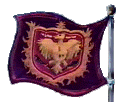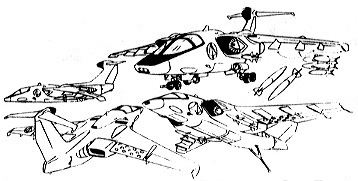

Designation:LTV A-12 Avenger II Attack Jet |

|

|
|||

|
|||||
| Total Length: | 18.3 m |
| Total Height: | 6.4 m |
| Total Wingspan: | 16.2 m |
| Total Dry Weight: | 10.5 metric tons |
Typical set for A-12C variant:
A and B variants
C variant
The skin of the Avenger is composed of an advanced titanium-steel alloy. The skin provides excellent protection against small grenade and shell fragments, good protection against small arms fire, and poor resistance to heavier infantry weapons, such as the 12.7mm machinegun round, as well as from fragments and near misses from higher caliber weapons. The armored 'bathtub' in the pilots' compartment stops all small arms fire, provides good protection against heavier infantry weapons, such as a 12.7mm machinegun round, and fair resistance to light mecha-mounted weaponry, such as the Zentraedi 22.3mm HE autocannon round. The Avenger provides full protection from nuclear, biological, and chemical hazards, using an overpressure cockpit environment activated by radiation and hazardous chemical sensors, or manually when biological warfare conditions are anticipated. The internal consumables supplies can provide atmosphere for twelve hours maximum.
The A-12 Avenger was a medium bomber designed to replace the A-6 in the US Navy. Although the USN had always wanted a stealth design, no plane was taken into production, and the attack arm of the carriers was converted to attack-loaded Tomcats and F/A-18E/F's. These craft were not precisely what the Navy wanted, and the search for a better plane went on. LTV took on the challenge, with assistance from Grumman when this company began to develop the radar-absorbing skin covers later installed on the F-203 Dragon. A conventional plane equipped with such a cover could become 'stealthy', and thus a simple, cheap plane would fulfill the Navy's demands. The resulting plane became the Avenger. Pilots often joked, when viewing the external form of the plane, that it was put together by committee: the nose resembled that of the F-111 Aardvark, the hull resembled that of an A-6 and the tail was reminiscent of the Blackburn Buccaneer. The engines were an off-the-shelf design also fitted to the F/A-18 Hornet, and the design - largely the result of the intense labors of Grumman's design teams - was of the same ruggedness that had given the Grumman the nickname 'Ironworks'. It was not armed with a cannon, although a cannon pod could be installed in its small internal bomb-bay, but two missiles in a conformal storage position under the engine nacelles were standard, and often the positions were filled by ALARM missiles so the Avenger could fight its way through anti-aircraft batteries to the target. In addition, there were eight underwing hardpoints. The Avenger was an immediate success. It was no surprise then when the UNDF decided to adopt the plane, and the plane was not only used on aircraft carriers, but, with a certain reluctance on the part of the UNDF Air Force's generals, it also equipped a large number of Air Force bomber wings. The plane received additional armor and a standard UNDF radar/electronic warfare system. The hardpoints were at a later date also fitted to take Stiletto multi-purpose missiles. In this form, the Avenger saw use during the Zentraedi uprisings. However, since the plane was definitely not a fighter, it was most often used as a more traditional bomber or as a stand-off missile launcher. As such, it saw service until 2020.
Return to UNDF Aircraft Index.
Go to Robotech Reference Guide Home Page.
Robotech (R) is the property of Harmony Gold. This document is in no way intended to infringe upon their rights.
Content by Pieter Thomassen and Peter Walker